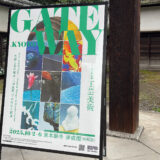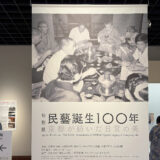
The “Kichirei-Kaomise-Kogyo”, a seasonal event that announces the arrival of winter in Kyoto in December, is being held again this year at Minami-za. This event is a special performance where actors from both the east and west of Japan come together to perform old and new masterpieces. The historic Minami-za stage, located near the Shijo Riverbank on the Kamo River, the birthplace of Kabuki, is the setting for Kabuki’s unique and spectacular world. This is a great opportunity for tourists and locals alike to come together and enjoy the full appeal of Kabuki.
This year, too, the main entrance to Minami-za is decorated with a sign in black ink with the names of the actors appearing in the play. The three-week performance began on December 1st.
The history of Kabuki and its unique appeal
Kabuki was born at the beginning of the 17th century and developed throughout the Edo period as a performing art representing Japanese popular culture. Its characteristics include gorgeous costumes, unique makeup, and bold acting style. The audience is drawn into the story as the actors’ every move stirs their hearts, an experience that cannot be experienced with other performing arts.
In particular, the stage art of Kabuki is closely related to the fine arts. The stage sets and props are elaborately hand-made by skilled artisans, and they richly express the world of the story. These symbolize how traditional Japanese craft techniques are closely linked to everyday life.

The appeal of Kabuki actors and their artistic expression
Kabuki actors are essential to its appeal. They draw the audience into the story’s world with their distinctive voices, dynamic movements, and skillful expression. In particular, the poses and make-up worn on stage are important elements that highlight the actors’ individuality. Mie is when an actor freezes for a moment in a particular scene to express the peak of his emotions, while kumadori is the bold lines drawn on the face that symbolize the character’s personality and role.
The appeal of these actors is not limited to their acting. They are people who boldly take on new challenges while continuing the techniques and performances that have been passed down from generation to generation, known as “house arts.” There is also a lot of attention being paid to new kabuki that incorporates modern sensibilities while preserving the classics.
They preserve the “house arts” and pass on techniques while incorporating new sensibilities in a way that is exactly the same as in the world of craft (kogei) art.

The popularity of actor prints in ukiyo-e
In the Edo period, kabuki was immensely popular as entertainment for the general public, and actors were a kind of star attraction. The popularity of kabuki was supported by the actor prints that appeared in ukiyo-e. Ukiyo-e artists drew the stage appearances of famous actors of the time and disseminated them to a wide audience.
For example, the actor prints of Tōshusai Sharaku are known for their unique style, with exaggerated facial expressions and sharp lines that bring out the actors’ individuality. Also, Kitagawa Utamaro and Utagawa Toyokuni reproduced the world of Kabuki in vivid colors with detailed, exquisite depictions. These actor prints were not only used to advertise Kabuki performances but were also highly coveted collections that fans of the time wanted to obtain.

Sharaku, Public domain, via Wikimedia Commons


by Toyohara Kunichika, Public domain, via Wikimedia Commons
Yakusha-e and modern art
The ukiyo-e yakusha-e is an example of how closely kabuki and art are linked. This tradition has continued into the present day, and new works have been created that fuse traditional and modern sensibilities based on the world of kabuki.




